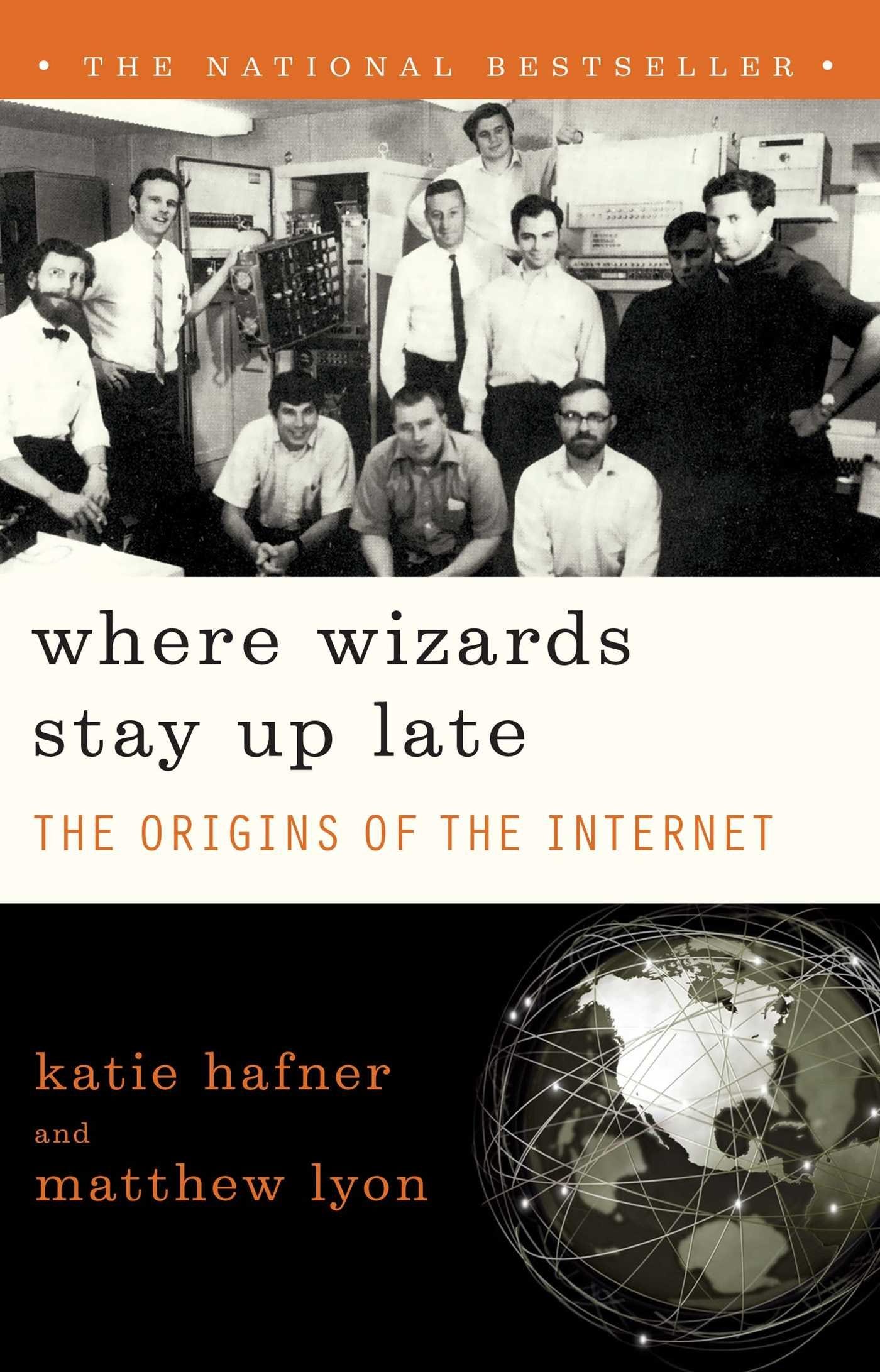
Review of Where Wizards Stay Up Late: The Origins of the Internet Katie Hafner, Matthew Lyon (Simon & Schuster Inc, 1997) ISBN: 0684832674 Reference on Amazon.co.uk
Originally published in WorldLink, the magazine of the World Economic Forum, whose Editor-in-Chief and Managing Director was Lance Knobel. The story the book tells reminds us of the possibilities of human ingenuity when the formula is right.
On the evening of Friday October 4 1957 the Soviet Union succeeded in launching the first Sputnik satellite into earth orbit, prompting President Eisenhower to remark that ‘the spectre of wholesale destruction’ now bore down on the American psyche. The events around Sputnik were undoubtedly dramatised to help the various services push their Cold War objectives, and Eisenhower responded in kind. A military man himself, he distrusted the ‘military-industrial complex’ and the fiefdoms of the armed services, but shared a love of science and sought to bring scientists more closely into the administration. He did this by setting up the Advanced Research Projects Agency, an agile R&D office that scientists could call on for project funding headed up by a civilian, Roy Johnson, formerly a vice president of General Electric.
ARPAs was conceived at the same time as NASA (the National Aeronautical and Space Administration) which opened its doors in late 1958 and took back many of the space and missile programs that had been ARPA’s domain. The Agency chose to redefine itself as a group that would take on really advanced ‘far out’ research, and develop a relationship with universities more than industry to build a community of the best technical and scientific minds in the country. This response was well suited to the changes taking place in Washington with the election of Kennedy and the installation of Robert S. McNamara as the new defence secretary, with his move from a philosophy of ‘massive retaliation’ to one of ‘flexible response’.
The change in direction also brought about change in directors, with Jack P. Ruina brought in as the third head of ARPA. The Agency went from strength to strength and began to focus more and more on computing. Ruina looked for someone to consolidate this direction and his attention fell upon JCR Licklider. A psychologist by training, Licklider had come to be an early advocate of the idea that computing could transform society. He believed that computers would allow more citizens to be ‘informed about, and interested in, the process of government’, that ‘the political process would essentially be[come] a giant tele-conference’. He was a brilliant but also selfless thinker, once insisting of his ideas that ‘it doesn’t matter who gets the credit; it matters that it gets done’.
In the context of ARPA Lick (as he liked to be known) shifted from focusing on war game scenarios to investigating time-sharing systems, computer graphics and improved computer languages. The office of Command and Control Research became the Information Processing Techniques Office (IPTO) and Lick was succeeded by Ivan Sutherland and then Bob Taylor, a psycho-acoustician by training. Being central to its work ARPA had access to computers across the country, but Taylor was frustrated by the lack of interconnectivity between them, making it difficult to share expensive computer resources. Inspired by Licklider’s ideas, he proposed funding the development of technology to link computers together and quickly received the approval of Charles Herzfeld, the head of ARPA. Larry Roberts, from MIT’s Lincoln Laboratory, was appointed to run the project.
The idea of a packet-switched network (as it came to be known) was also conceived by Paul Baran, working at RAND, and Donald Davies — who originally coined the term ‘packet’ — at Britain’s National Physics Laboratory, the former looking at creating a militarily defensible network, the latter interested in a new telecommunications network. Baran’s research was stymied by AT&T, displaying the famous ‘not invented here’ attitude and dropped after a few years. Roberts had heard of Davies’s earlier work, but not of his work in packet switching, and only came across Baran’s work a few years later. Roberts developed the idea of a distributed network and concluded that such a network would need intermediate computers — later known as Interface Message Processors (IMPs) — that then connected to the individual host computers.
The contract to build the IMP was awarded to Bolt Beranek and Newman, a Cambridge, Mass.-based consulting firm that had started life in 1948 in the field of acoustics, and had employed Licklider prior to his term at the IPTO. BBN had nine months to build the first IMP, to be installed on Labour Day 1969 at UCLA and, under the guidance of Frank Heart, the deadline was met and ARPANET was born. The network expanded to four nodes by the beginning of 1970 and exponentially from there on, and gradually became a critical element for any university research funding.
The proceeding years were characterised by a search for protocols both for the interaction of the computers on the network and for the collaboration of those who had pioneered it. The Network Working Group emerged and Steve Crocker distributed the first Request for Comment document (RFC), a format that became central to the proposal of new standards. Email was a relatively late development, and, far from the killer application we know today, did not even automate the addressing of replies. The most significant development that laid the foundations for the Internet we know now were Transmission Control Protocol and Internet Protocol (TCP/IP), methods for routing data between systems on a peer-to-peer basis. TCP/IP was largely the brainchild of Vint Cerf, who went on to become a senior vice president at MCI.
In the mid-70s Bob Metcalfe pioneered Ethernet at Xerox PARC as a practical way of internetworking over a local area. The ability of these networks to talk TCP/IP and ‘internetwork’ created the momentum for the Internet, and in 1983 the original ARPANET moved over to TCP/IP. By the late 80s networking was becoming big business and TCP/IP stood to become the de facto standard, partly helped by Sun Microsystem’s early adoption of the protocol for its Unix workstations. The final obstacle was the Open Systems Interconnection standard of the ISO, but this was finally undermined by a pragmatic adoption of TCP/IP as a technology that had been tried and had worked rather than an being an abstract standard like OSI. By the end of the 80s ARPANET had become redundant and was closed down, and commercial traffic had been allowed onto the network, now funded by the National Science Foundation. The NSF withdrew funding in 1995 and the Internet as we know it had been born.
Hafner and Lyon did extensive research for ‘Wizards’, including interviewing many of the leading players in the story. They recount events as if they were there, bringing in enough background to allow the reader to know the characters as if they were protagonists in a novel — even adding suspense when describing events like the race to install the first IMP at UCLA. Hafner’s knowledge of the Internet of today — as a contributing editor at Newsweek and co-author of Cyberpunk: Outlaws and Hackers on the Computer Frontier — gives sufficient perspective to be able to explain the significance of historical developments to readers who have only limited experience of the Internet. However, a useful addition to the book would have been a timeline showing the principal characters, institutions and technologies discussed — overcoming the feeling that one is reading One Hundred Years of Solitude.
Overall, the story of Wizards is a testament to benefits of a faith in science tied to a broader social vision (particularly in the case of Licklider) and a refusal to be daunted by received wisdom and established authority. The Internet happened despite AT&T, IBM and the International Standards Organisation. Until two years ago it was happening without Microsoft. We must hope that the same innovative work is going on today hidden (for now) inside our universities, but current constraints on governments’ spending and a general lack of support for scientific experimentation likely mean this is not the case. At least Where Wizards Stay Up Late reminds us of the possibilities of human ingenuity when the formula is right.
Citation: From IMP to Net (review of ‘Where Wizards Stay Up Late: The Origins of the Internet’), Nico Macdonald, WorldLink, January/February 1997, p109
[Notes] [Tasks]
